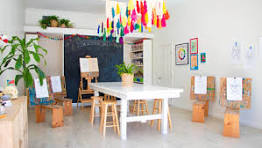The Art Room: Where Creativity Takes Flight
The Art Room: A Sanctuary for Creativity
Art rooms are more than just physical spaces; they are sanctuaries where creativity flourishes and imaginations run wild. Whether in a school, a community centre, or a professional studio, the art room is where artists of all ages and backgrounds come together to express themselves through various mediums.
Walking into an art room is like stepping into a world of endless possibilities. The walls are adorned with colourful paintings, sketches, and collages that tell stories of passion and inspiration. The smell of paint and the sound of pencils scratching against paper create an atmosphere that ignites the creative spirit within each individual.
For many, the art room is a place of solace and self-discovery. It is where emotions are translated into visual masterpieces, where mistakes are embraced as part of the creative process, and where individuality is celebrated. In this space, artists can experiment with different techniques, learn from one another, and grow both artistically and personally.
Art rooms serve as incubators for talent and innovation. They provide a platform for emerging artists to showcase their work, receive feedback from peers, and collaborate on projects that challenge conventional norms. Through workshops, exhibitions, and artist residencies, art rooms foster a sense of community among creatives who share a common love for artistic expression.
Ultimately, the art room is more than just a physical location; it is a state of mind—a place where boundaries fade away, inhibitions vanish, and creativity knows no limits. It is where dreams take shape on canvas, sculptures come to life in clay, and visions manifest into reality.
Exploring Art Rooms: Key Concepts and Essentials for Creative Spaces
- What are the 7 types of art?
- What is meant by art room?
- What is the 70/30 rule in art?
- What is an art studio called?
- What is the function of art room in school?
- What is needed in an art room?
What are the 7 types of art?
The question “What are the 7 types of art?” often arises in discussions about the diverse forms of artistic expression. While the categorisation of art can vary, some commonly recognised types include visual arts (such as painting, drawing, and sculpture), performing arts (including theatre, dance, and music), literary arts (such as poetry and prose), decorative arts (like ceramics and textiles), digital arts (including graphic design and animation), applied arts (such as architecture and industrial design), and culinary arts. Each type of art offers a unique avenue for creativity and self-expression, contributing to the rich tapestry of human culture and innovation.
What is meant by art room?
An art room typically refers to a designated space, whether in a school, community centre, or studio, where individuals engage in artistic activities and creative expression. It serves as a hub for artists of all levels to explore various mediums such as painting, drawing, sculpture, and more. The art room is not just a physical location but a nurturing environment where imagination thrives, ideas are born, and artistic skills are honed. It provides a platform for individuals to unleash their creativity, experiment with different techniques, and collaborate with like-minded individuals in a setting that encourages self-expression and artistic growth.
What is the 70/30 rule in art?
The 70/30 rule in art refers to a compositional guideline that suggests the ideal balance between positive and negative space within a piece of artwork. According to this rule, a composition should consist of approximately 70% positive space (the main subject or elements) and 30% negative space (the empty or background areas). This rule helps artists create visually appealing and well-balanced compositions by ensuring that the subject has enough breathing room to stand out while also allowing for surrounding space to complement and enhance the overall aesthetic impact of the artwork. By understanding and applying the 70/30 rule, artists can effectively manipulate spatial relationships within their compositions to create engaging and harmonious visual experiences for viewers.
What is an art studio called?
An art studio is commonly referred to as a creative space where artists work and bring their artistic visions to life. It serves as a sanctuary for artistic expression, experimentation, and innovation. Within an art studio, artists can explore various mediums, techniques, and styles to create their artworks. It is a place where inspiration flows freely, ideas are nurtured, and the boundaries of traditional artistry are often pushed. The term “art studio” encapsulates the essence of a dedicated environment where creativity thrives and where artists find the freedom to explore their craft with passion and purpose.
What is the function of art room in school?
The function of an art room in a school goes beyond being just a physical space for creative activities. It serves as a hub for nurturing artistic talents, fostering self-expression, and promoting critical thinking skills among students. In the art room, students have the opportunity to explore various artistic mediums, experiment with different techniques, and unleash their creativity in a supportive environment. Through engaging in art projects, students develop problem-solving abilities, enhance their communication skills, and gain a deeper appreciation for the arts. The art room plays a vital role in encouraging individuality, building confidence, and instilling a lifelong love for creativity in students across all ages and backgrounds.
What is needed in an art room?
In an art room, several essential elements are required to facilitate a conducive environment for creativity and artistic expression. Firstly, ample natural light is crucial to illuminate the space and showcase artworks effectively. A variety of art supplies such as paints, brushes, pencils, and paper should be readily available to support artists in their creative endeavours. Additionally, storage units or shelves are essential for organising materials and keeping the workspace tidy. Comfortable seating and work surfaces are necessary to ensure artists can focus on their craft comfortably. Furthermore, inspirational artwork displayed on the walls can stimulate creativity and provide visual references for aspiring artists. Lastly, a supportive and encouraging atmosphere created by both peers and mentors is vital in nurturing artistic talent and fostering a sense of community within the art room.


